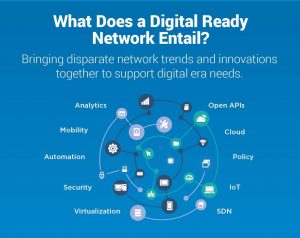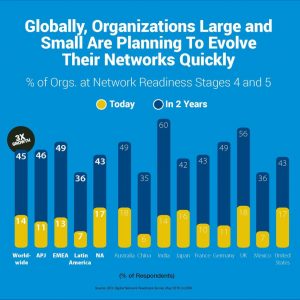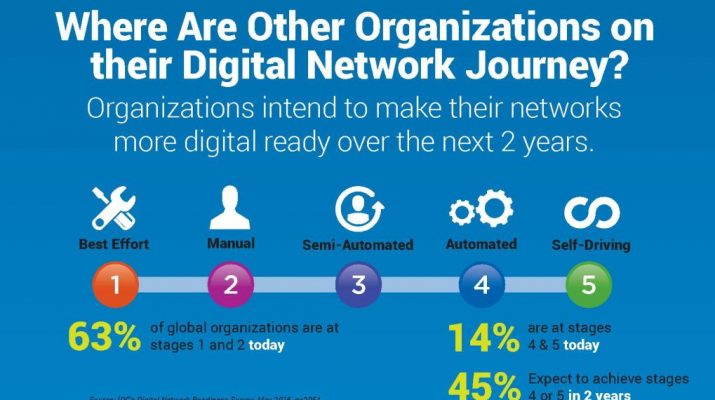45 percent of organizations plan to invest in digital-ready networks over the next two years, reveals new study by Cisco
 According to a newly released IDC study, organizations around the world are expected to triple the adoption of modern, automated networks over the next two years. To accelerate the journey to these digital-ready networks, Cisco is introducing new technologies that allow customers to virtualize and secure their networks.
According to a newly released IDC study, organizations around the world are expected to triple the adoption of modern, automated networks over the next two years. To accelerate the journey to these digital-ready networks, Cisco is introducing new technologies that allow customers to virtualize and secure their networks.
Today, businesses demand a lot from their networks. However, the vast majority of today’s networks were only designed to provide fast, reliable connectivity. These legacy networks are struggling to combat sophisticated cyber-threats, or keep up with the requirements of today’s mobile workforce and their use of IoT devices and new cloud applications. A new approach is required. With its Digital Network Architecture (DNA), Cisco is ushering in a new era of networking that rips up the playbook for how companies build and manage network infrastructure.
Network virtualization and integrated security are foundational elements of Cisco DNA. Cisco is introducing a new hardware platform and virtual network services to extend virtualization to branch locations, as well as a new solution that allows customers to virtualize their network perimeter and extend it to colocation centers. Cisco is also the first in the industry to deliver software-defined segmentation across the entire network—from the network to the endpoint to the cloud – with complete application visibility.
Deploying Services in Minutes
Over the past decade, IT teams have changed how they design and deploy data centers to help their organizations take advantage of virtualization and cloud computing. Now enterprise networks are going through a similar change. With Cisco DNA, organizations can now extend network services, like routing or security, to a diverse set of platforms across branch, campus, colocation centers and the public cloud. By decoupling hardware from software, Cisco DNA allows for greater speed and flexibility.
Cisco is building on the industry’s broadest set of network virtualization solutions with innovations in two key areas:
- Enterprise Network Functions Virtualization (NFV) Platform is an emerging technology that boosts flexibility and agility for remote locations by virtualizing branch networks. Cisco is introducing a new, purpose-built branch platform, Cisco Enterprise Network Compute System (ENCS 5400 Series), to help customers accelerate their Enterprise NFV ENCS allows customers to extend routing, security, WAN optimization and other network services to their branch environments.
- Virtualizing the Network Perimeter: The network perimeter is an organizations’ gateway to the Internet. But traditional, static network perimeters are struggling with the new realities of the digital era. The new Cisco Secure Agile Exchange solution virtualizes the network perimeter and extends it to colocation centers. This allows organizations to dynamically connect customers, employees and partners using on-demand, virtualized network services.
Boosting Threat Visibility and Enforcement
 The network can provide deep visibility into network traffic patterns and rich threat intelligence. With Cisco DNA, the network can be used to quickly detect cybersecurity threats and then automatically take action to stop them.
The network can provide deep visibility into network traffic patterns and rich threat intelligence. With Cisco DNA, the network can be used to quickly detect cybersecurity threats and then automatically take action to stop them.
New security features introduced include:
- Visibility and Control: Cisco Identity Services Engine(ISE) provides visibility and control of users and devices on the network. ISE 2.2 offers much deeper visibility into applications on endpoints, including detection of anomalous behavior. It also offers more granular control with the ability to define “DEFCON†policy sets that allow customers to escalate their response to prolific threats.
- Software-defined Segmentation: Cisco TrustSecprovides software-defined segmentation to isolate attacks and restrict movement of threats in the network. This dynamic segmentation makes security policy changes 98 percent faster than traditional methods, with an 80 percent reduction in operational efforts. TrustSec 6.1 is now available across Cisco’s entire enterprise networking portfolio and integrates with Cisco ACI. With these advancements, TrustSec enables dynamic segmentation anywhere on the network, from the edge to the data center and cloud.
IDC Study Highlights
Cisco also unveiled the results of a major global study into the adoption rates of digital-ready networks. Conducted by IDC and commissioned by Cisco, the research surveyed 2,054 global organizations across 10 countries to determine the digital readiness of their networks.
Key findings include:
- Organizations clearly recognize the need to evolve their networks: Over the next two years, 45 percent of organizations expect to achieve digital-ready network capabilities. That represents three times the current adoption rates.
- Modern networks are delivering real, tangible benefits: Companies that have invested in modern network capabilities are experiencing 2-3 times the rate of growth in revenue, customer retention and profit. They have also deployed twice as many digital transformation initiatives compared to companies with legacy networks.
- Adoption rates comparable across company size and industry vertical: It turns out that network maturity levels are comparable across market segments, with minimal variation between mid-market (500-999 employees) and large (1000+) organizations.
- Emerging countries to leapfrog developed nations: The real variance occurs when comparing countries. The most significant jump in maturity is expected to occur in emerging economies.
To help customers navigate the complex journey to a digital-ready network, Cisco is introducing a series of new tools and services. Network assessment tools will help customers understand where they are on the journey, plot a roadmap and understand the business benefits of continuing on their path to digital network maturity. Cisco is also introducing new DNA Advisory Services that will offer in-depth consulting to help enterprises formulate a unique strategy that maps directly to their digital aspirations.


